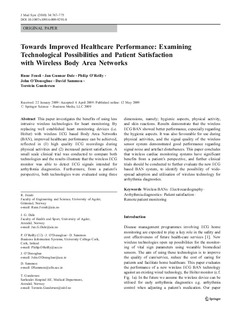| dc.contributor.author | Fensli, Rune | |
| dc.contributor.author | Dale, Jan Gunnar | |
| dc.contributor.author | O'Reilly, Philip | |
| dc.contributor.author | O'Donoghue, John | |
| dc.contributor.author | Sammon, David | |
| dc.contributor.author | Gundersen, Torstein | |
| dc.date.accessioned | 2010-11-29T10:16:22Z | |
| dc.date.available | 2010-11-29T10:16:22Z | |
| dc.date.issued | 2010 | |
| dc.identifier.citation | Fensli, R., Dale, J. G., O'Reilly, P., O'Donoghue, J., Sammon, D., & Gundersen, T. (2010). Towards Improved Healthcare Performance: Examining Technological Possibilities and Patient Satisfaction with Wireless Body Area Networks. Journal of Medical Systems, 34(4), 767-775. doi: 10.1007/s10916-009-9291-8 | en_US |
| dc.identifier.issn | 0148-5598 | |
| dc.identifier.uri | http://hdl.handle.net/11250/137833 | |
| dc.description | Published version of an article from the journal: Journal of Medical Systems. he original publication is available at Springerlink. http://dx.doi.org/10.1007/s10916-009-9291-8 | en_US |
| dc.description.abstract | This paper investigates the benefits of using less intrusive wireless technologies for heart monitoring. By replacing well established heart monitoring devices (i.e. Holter) with wireless ECG based Body Area Networks (BAN), improved healthcare performance can be achieved, reflected in (1) high quality ECG recordings during physical activities and (2) increased patient satisfaction. A small scale clinical trial was conducted to compare both technologies and the results illustrate that the wireless ECG monitor was able to detect ECG signals intended for arrhythmia diagnostics. Furthermore, from a patient’s perspective, both technologies were evaluated using three dimensions, namely; hygienic aspects, physical activity, and skin reactions. Results demonstrate that the wireless ECG BAN showed better performance, especially regarding the hygienic aspects. It was also favourable for use during physical activities, and the signal quality of the wireless sensor system demonstrated good performance regarding signal noise and artefact disturbances. This paper concludes that wireless cardiac monitoring systems have significant benefits from a patient’s perspective, and further clinical trials should be conducted to further evaluate the new ECG based BAN system, to identify the possibility of widespread adoption and utilisation of wireless technology for arrhythmia diagnostics. | en_US |
| dc.language.iso | eng | en_US |
| dc.publisher | Springer | en_US |
| dc.title | Towards Improved Healthcare Performance: Examining Technological Possibilities and Patient Satisfaction with Wireless Body Area Networks | en_US |
| dc.type | Journal article | en_US |
| dc.type | Peer reviewed | en_US |
| dc.subject.nsi | VDP::Medical disciplines: 700::Health sciences: 800::Health service and health administration research: 806 | en_US |
| dc.subject.nsi | VDP::Technology: 500::Information and communication technology: 550 | en_US |
| dc.source.pagenumber | 767-775 | en_US |

